What is sugar beet: the full path from sowing a vegetable to the resulting sugar on our table
Sugar beets are not as popular with summer residents as canteen varieties... However, it is of colossal importance as a raw material for industrial sugar production. The advantage of this crop is the waste-free use of the entire plant, including the foliage used as animal feed, organic fertilizer, etc.
The content of the article
Sugar beet and its beneficial properties
The historical ancestor of the canteen, fodder and sugar beets is the wild beet, common in India and the Far East. Of this triad, sugar is the "youngest" culture. Breeders bred it only at the beginning of the 19th century, although the German chemist Andreas Marggraf found out in the middle of the 18th century that sugar extracted from cane is also found in beets.
Having adopted the secrets of processing beet juice, Russia established the sugar industry and became the world leader in the cultivation of sugar beet. In 2016, 51.4 million tons of crops were produced.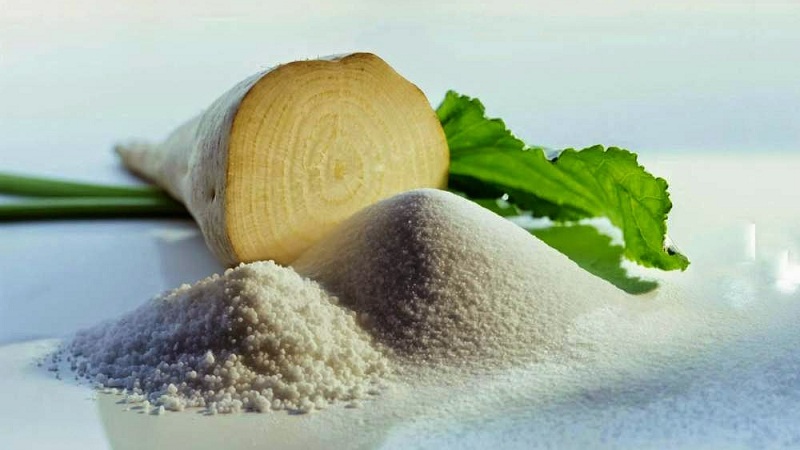
Composition and calorie content
100 g of product accounts for: 45 kcal, 1.5 g of protein, 0.1 g of fat, 9.1 g of carbohydrates. The vegetable also contains 2 g of fiber and 2.5 g of dietary fiber, 86 g of water and 1 g of ash.
Of particular importance is the high content of mono- and disaccharides: glucose, galactose, arabinose, fructose.
The chemical composition of sugar beet includes:
- vitamins A, E, PP, C, group B;
- macronutrients: potassium, calcium, sodium, phosphorus;
- trace elements: iodine, iron, copper, manganese, zinc;
- bioflavonoids;
- pectin;
- betaine.
Thanks to these substances, the vegetable helps to increase immunity, improve digestion and metabolism. Regulates the work of the heart and blood vessels, promoting the production of hemoglobin and lowering cholesterol levels. Increases the number of red blood cells.
Beetroot contains a large number of antioxidants, which means it prevents the development of cancer. High iodine content improves thyroid function in hypothyroidism. The use of the product is included in the prevention of rickets in children.
Harm and contraindications for use
Despite its rich chemical composition and a lot of useful properties, sugar beets have contraindications and are prohibited:
- with hypotension due to the ability to significantly lower blood pressure;
- with kidney disease, gout and rheumatoid arthritis (oxalic acid contained in beets promotes the formation of oxalate stones and sand);
- with chronic diarrhea, since the vegetable has a laxative effect;
- with increased acidity in the stomach, which can be aggravated by oxalic acid, and dietary fiber additionally irritates the mucous membrane.
First of all, the recommendations relate to the use of raw root vegetables and juice from it, however, boiled beets should not be abused either.
What does sugar beet look like and how is it different from feed
Sugar beet is a biennial plant of the amaranth family. In the first year, an elongated root crop with a tough white flesh and a root rosette of leaves are formed.In the second year, generative organs sprout.
The root system consists of the main rod and lateral roots extending from it, reaching 50 cm in width and up to 3 m in depth. The main root consists of a head with leaves, a root collar and a succulent root crop.
The green mass is rich: in one rosette there are up to 50-60 green, smooth leaves with tall cuttings.
In the photo - sugar beet.
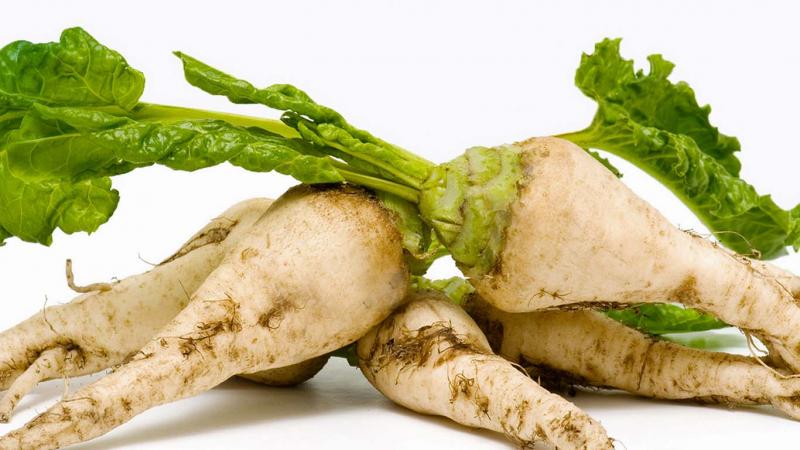
Fodder beets differ from sugar beets:
- appearance (roots can be of different shapes and colors);
- a shorter vegetative cycle (the difference is 30 days);
- chemical composition (it contains more protein and less carbohydrates, including sugars).
Areas of sugar beet growing in the Russian Federation and its importance
The conditions of the Central Black Earth Region (Kursk, Lipetsk, Tambov, Voronezh, Belgorod regions) are most suitable for cultivation in the vastness of Russia. It accounts for half of the cultivated areas of vegetables (167.7 thousand sq. Km).
About 18% of sugar beet production is concentrated in the Krasnodar Territory (according to the expert and analytical center for agribusiness).
Sugar beet is of great importance for the industrial sugar production as well as for livestock feed.
The advantage of the culture is that the vegetable is used completely, without waste:
- alcohol, citric acid, glycerin, yeast are produced from molasses;
- defecate is used as plant fertilizer;
- pulp serves as a succulent feed for animals, including cattle and pigs;
- The recovered ethanol, when mixed with gasoline and diesel, becomes a form of biofuel.
Growing technology
Sugar beets are heat, light and moisture demanding. Feels good in a temperate sunny climate. Equally poorly tolerates prolonged torrential rains and drought. Optimum temperature for germination is + 20 ... 25 ° С, for growth and sugar synthesis - + 30 ° С.
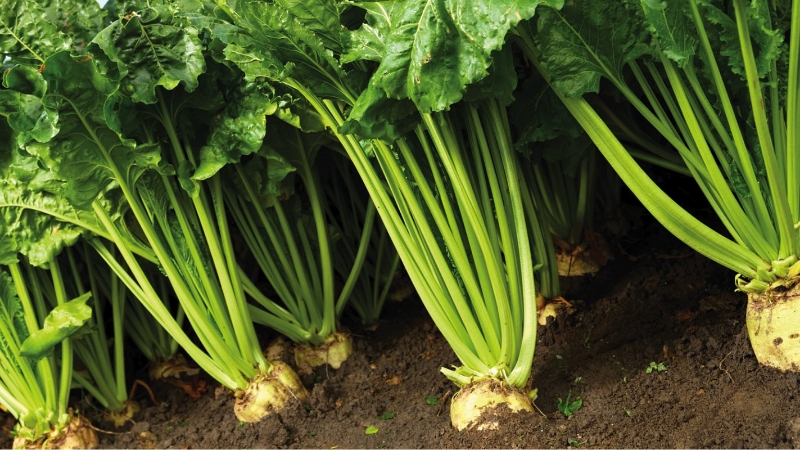
Precursors for beets in crop rotation
Sugar beet not grown as a monoculture. It is sown after winter wheat and rye, some root crops, for example, onions, potatoes, and representatives of the legume family.
If sugar beet is often sown in the same field, pathogens of characteristic diseases and pests, primarily beet nematode. It also affects fodder and table beets, spinach, crucifers (cabbage, radish, mustard, rapeseed). A break in planting such crops should be from 3 to 7 years.
Preparing the soil for sowing
Sugar beet loves well-drained, loamy, sod-podzolic soils, as well as chernozems and peatlands. It is especially demanding on the acidity of the soil, the optimal pH is from 6.5 to 7% (slightly acidic, neutral).
Before sowing, the soil is enriched with organic and mineral complexes, plowed and leveled. Root crops need good aeration and drainage, and large clods of soil and weeds can inhibit root crop development. A distance of at least 50 cm is left between the furrows so as not to crowding the roots and not to interfere with irrigation.
Reference. As a prophylaxis of diseases, wood ash and boron are introduced into the soil. Ash lowers the acidity of the soil, and boron is not readily available in soils with high pH levels.
Seed preparation
The seed factories carry out special processing processes that accelerate the emergence of seedlings and increase the productivity of sowing:
- Pelleting - covering the seeds with a protective nutritive shell made of a mixture of neutralized peat, humus, adhesive (mullein or polyacrylamide), mineral and bacterial fertilizers and growth stimulants.
- Enveloping protective and stimulating substances against pathogenic microorganisms.
Powered seeders are used commercially and no additional seed preparation is performed.When growing beets for personal needs, the seed material is pre-soaked in warm water for 8-10 hours, for example, overnight.
Sowing technology
Sowing sugar beets is carried out when the soil has warmed up to at least + 6 ° C. The culture is not afraid of light frosts, but for growth and development it needs a temperature of at least + 20 ° C. For planting, a sunny site is chosen, since in the shade the beets go into the growth of green mass, and not root crops.
Seeds are laid in fertilized and moistened soil to a depth of 2 to 4 cm, a distance of 50 cm is kept between rows. Under favorable conditions, seedlings appear on the 4th-5th day.
Crop care
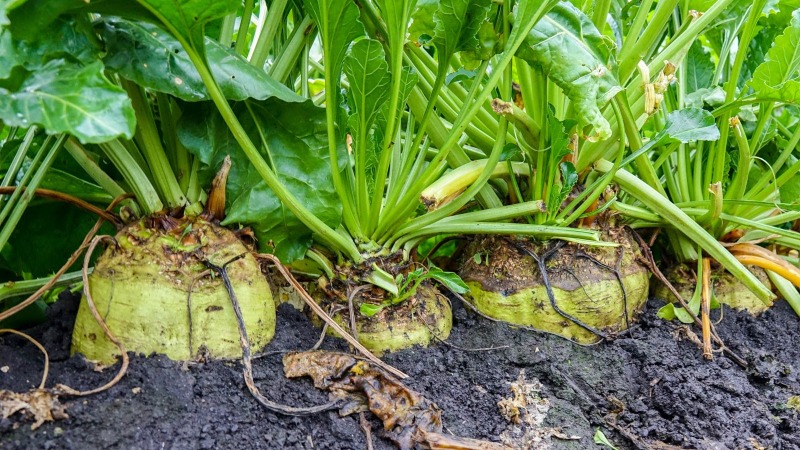
Sugar beets do not respond well to stagnant water, therefore, a drainage system and regular soil loosening are of particular importance. Watering on loose textured soils, it is produced twice a week, on heavy loamy soils - once a week. In order for the root crops to accumulate the maximum amount of sugars, watering is stopped two weeks before harvesting.
Weeds interfere with normal plant growth - they compete with industrial crops for nutrients in the soil and sunlight. For good yields, manual weeding and inter-row harrowing are necessary.
As feeding use complex fertilizers: "Nitrofosku", "Nitroammofosku", "Ammophos", "Diammonium phosphate".
Depending on the type of soil, micronutrient fertilization may be required:
- copper-containing - on sod-podzolic soils;
- manganese, cobalt and molybdenum - on leached chernozem.
Protection from pests and diseases
Dangerous for sugar beets:
- Corneed - fungal disease. It affects mainly young plants (before the formation of the second pair of leaves), it is expressed in root decay.
- Peronosporosis (downy mildew). It is of fungal origin, affects the aboveground organs, on which a gray-purple bloom is formed.
- Cercosporosis - spots of ashy color with a reddish-brown border, caused by the development of a fungus. Promotes the accumulation of harmful nitrogen in fruits.
- Fomoz (zonal spotting). It manifests itself in the form of yellow or light brown spots with concentric zones, black dots appear inside over time - accumulations of fungal spores.
- Ascochitosis - bluish-green, gradually turning brownish round spots.
- Rhizoctonia (red rot). Affects roots. Looks like depressed spots covered with a dark purple mycelium. Leads to crop failure.
- Fusarium rot. It begins with blackening of the roots, and in the underground part there is an excessive development of lateral roots and tissue necrosis inside the root crop.
- Dry sclerocyosis - dry spots and longitudinal cracks on the fruit.
- Scab - scab-like crusts or cracks, gradually growing into corky tissue.
To combat diseases, they use:
- biological methods: stubble plowing, deep plowing, removal of weeds, attraction of beneficial organisms such as ladybirds, etc .;
- chemical agents - fungicides and pesticides.
Harvesting and storage of crops
It takes 110-140 days to ripen sugar beets.
The signs of ripeness are:
- yellow leaves;
- exposing the top of the root crop.
Harvesting is possible by hand or using special equipment.
Store root vegetables in a cool, well-ventilated area, protected from direct sunlight.
Technology of processing sugar beet into sugar
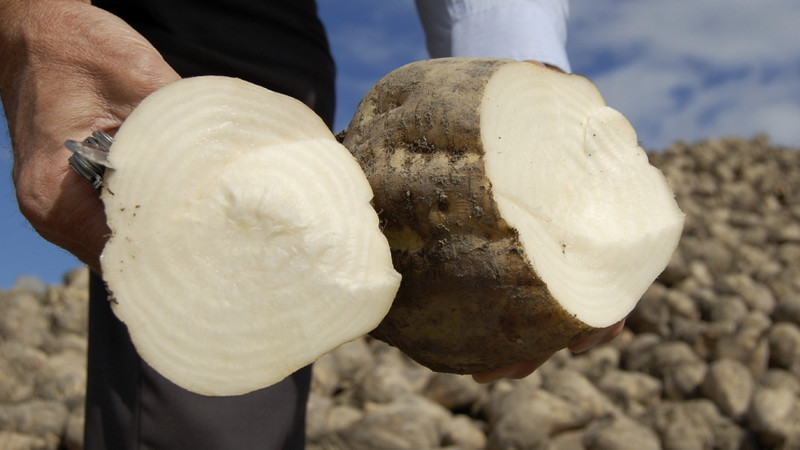
The process includes the following steps:
- Impurities that interfere with the work of beet threshers and degrade the quality of the product are separated from the beets. For this purpose, special traps are installed on the hydraulic conveyor.
- In the beet washing root crops are cleaned of adhering soil and other contaminants.
- The beets are crushed into shavings to extract the sugar faster and more efficiently.
- The shavings are placed in water heated to 70 ° C, and due to diffusion the sugar turns into a liquid.
- The resulting syrup (raw juice) contains 1-2% non-sugar impurities and only 13-15% sugar itself.Therefore, it needs to be cleaned first with milk of lime - the so-called pre-defecation; then juice is treated with saturation gas - saturation process takes place. The purified juice thickens and changes color from black to pale yellow.
- As an intermediate step, filtration and decolorization with sulfur dioxide (sulfitation) are carried out.
- To get rid of excess moisture, the syrup is subjected to thermal evaporation. After that, it contains about 70% sugar.
- Sugar crystallizes in vacuum apparatus. The result is massecuite - a mixture of sugar crystals and a sugar solution (in a 1: 1 ratio).
- In a rotating centrifuge, the massecuite breaks down into crystals of white sugar and brown syrup - an outflow. The effluent can be boiled down again in vacuum bags, and then driven through a centrifuge. The crystals are dried and granulated sugar is obtained.
Sugar production has by-products that are successfully used in other areas:
- de-sugared pulp (beet pulp) is used in the manufacture of animal feed;
- the filter cake becomes a fertilizer;
- the molasses left over after the massecuite is passed through centrifuges is used in the production of yeast and alcohol.
Reference. In addition to crushed sugar, it is possible to make seeded (with crystals of a certain size), liquid, invert (resistant to crystallization) sugar, gold and amber syrups, molasses, and with the addition of cane molasses - brown sugar.
Other uses for sugar beet
Chopped beets can be used as a natural sweetener for cereals, compotes and other dishes, for the production of alcoholic beverages and as pet food.
Moonshine
Due to the high sugar content when yeast is added, beet syrup is actively fermented.
The classic recipe for mash requires:
- 5 kg of sugar beet;
- 10 liters of water;
- 50 g dry yeast.
With the help of double distillation in a moonshine, the mash is filtered to absolute alcohol, and then diluted with water to the desired strength.
Reference. In Ukraine, the drink is called "buryachikha", and in Russian villages - "kosorylovka". It has a pungent smell, quickly intoxicates and causes severe hangovers.
Can rabbits and other animals be given
It is profitable to use sugar beet as a fodder crop... Firstly, it has a high nutritional value and a number of useful properties, the carbohydrates contained are easily digested. Secondly, not only root crops are used, but also the tops of the plant.
 Beetroot fruits are given to animals fresh and dried or as part of silage. The most nutritious is the silage made from sugar beets, boiled potatoes and green pulses. Beet pulp, a by-product of sugar production, is added to the feed for cattle and pigs.
Beetroot fruits are given to animals fresh and dried or as part of silage. The most nutritious is the silage made from sugar beets, boiled potatoes and green pulses. Beet pulp, a by-product of sugar production, is added to the feed for cattle and pigs.
Rabbits are taught to sugar beet gradually to avoid unwanted gastrointestinal reactions. Acquaintance with the root crop begins at the age of one month.
The daily allowance is only 50 g, but it is split into two meals. From 2 to 3 months, rabbits are given 100 g of sugar beet per day, from 3 to 4 months - 150 g. Adults can eat up to 500 g of a vegetable without harm to health, but a single dose should not exceed 150-200 g.
Beet tops are best served dried or added to silage.
Reference. Sugar beet has a beneficial effect on the condition of the fur of animals, making their meat especially tasty and nutritious.
Dependence of yield and productivity on the variety
The world average yield of sugar beet is 34.3 t / ha; in Russia, an average of 17.8 t of root crops is harvested per hectare. The highest yield is observed in the Central Black Earth Region - up to 30 t / ha, but this is much less than in countries with a high agricultural culture, where about 50-60 t / ha are harvested.
The efforts of breeders are aimed at improving such qualities of a vegetable as:
- yield, which does not always correlate with sugar content;
- sugar yield (today this figure reaches more than 20%);
- resistance to diseases and pests.
The varieties are conventionally divided into three categories:
- fruitful (high productivity against the background of low sugar content of root crops - 16.5%);
- high-yielding sugar (with sugar content up to 18.5% and average yield);
- sugary (have the lowest yield, but the sucrose content reaches 21.5%).
Conclusion
Sugar beets can be grown not only on an industrial scale for sugar production, but also on a personal plot. The choice of the crop is justified in view of its high productivity and a wide range of uses: as animal feed, as a natural sweetener in dishes and as a raw material for the production of homemade alcohol.